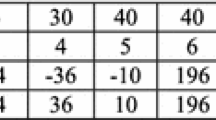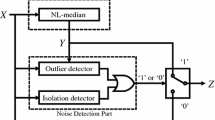Abstract
According to the B-spline convolution mask, first, the contrast sensitiveness (CS) is computed and then is viewed as a noise sensitiveness coefficient (NSC) to adaptively determine a noise-recognized threshold value. Based on the noise density function (NDF) in a 3×3 window, the filtering window size is adaptively adjusted, and then a median filter is used to eliminate the noise-marked pixels. The experiment results show that the proposed algorithm can preserve image detail information well and effectively remove the noises, particularly the impulse noises that is also called salt-and-pepper noises superimposed on the computed tomography (CT) and magnetic resonance imaging (MRI) medical images.
Similar content being viewed by others
References
R. H. Chan, C. W. Ho, M. Nikolova. Salt-and-pepper noise removal by median-type noise detectors and detail-preserving regularization. IEEE Transactions on Image Processing, vol. 14, no. 10, pp. 1479–1485, 2005.
A. Toprak, I. Guler. Suppression of impulse noise in medical images with the use of fuzzy adaptive median filter. Journal of Medical Systems, vol. 30, no. 6, pp. 465–471, 2006.
W. Luo. An efficient detail-preserving approach for removing impulse noise in images. IEEE Signal Processing Letters, vol. 13, no. 7, pp. 413–416, 2006.
S. M. Zhou, J. Q. Gan, L. D. Xu, R. John. Interactive image enhancement by fuzzy relaxation. International Journal of Automation and Computing, vol. 4, no. 3, pp. 229–235, 2007.
X. H. Yang, L. C. Jiao, D. F. Li. Directional filter for SAR images based on nonsubsampled contourlet transform and immune clonal selection. International Journal of Automation and Computing, vol. 6, no. 3, pp. 245–253, 2009.
S. N. Madhu, K. Revathy, R. Tatavarti. An improved decision-based algorithm for impulse noise removal. In Proceedings of Congress on Image and Signal Processing, IEEE, San Diego, CA, USA, vol. 1, pp. 426–431, 2008.
K. S. Srinivasan, D. Ebenezer. A new fast and efficient decision-based algorithm for removal of high density impulse noises. IEEE Signal Processing Letters, vol. 14, no. 3, pp. 189–192, 2007.
Y. Q. Dong, S. F. Xu. A new directional weighted median filter for removal of random-valued impulse noise. IEEE Signal Processing Letters, vol. 14, no. 3, pp. 193–196, 2007.
H. Y. Zhou, T. W. Liu, F. Q. Lin, Y. S. Pang, J. Wu. Image restoration and detail preservation by Bayesian estimation. International Journal of Image and Graphics, vol. 7, no. 3, pp. 497–514, 2007.
X. Y. Xu, E. L. Miller, D. B. Chen, M. Sarhadi. Adaptive two-pass rank order filter to remove impulse noise in highly corrupted images. IEEE Transactions on Image Processing, vol. 13, no. 2, pp. 238–247, 2004.
Y. L. You, M. Kaveh. Fourth-order partial differential equations for noise removal. IEEE Transactions on Image Processing, vol. 9, no. 10, pp. 1723–1730, 2000.
R. Garnett, T. Huegerich, C. Chui, W. J. He. A universal noise removal algorithm with an impulse detector. IEEE Transactions on Image Processing, vol. 14, no. 11, pp. 1747–1754, 2005.
U. Michael, A. Aldroubi, M. Eden. B-spline signal processing: Part I — Theory. IEEE Transactions on Signal Processing, vol. 41, no. 2, pp. 821–833, 1993.
U. Michael, A. Aldroubi, M. Eden. B-spline signal processing: Part II — Efficiency design and applications. IEEE Transactions on Signal Processing, vol. 41, no. 2, pp. 834–848, 1993.
T. M. Lehmann, C. Gönner, K. Spitzer. Survey: Interpolation methods in medical image processing. IEEE Transactions on Medical Imaging, vol. 18, no. 11, pp. 1049–1075, 1999.
F. M. Rong, B. C. Shi. Wavelet designing based on slant transform and application. Computer Engineer and Applications, vol. 43, no. 10, pp. 27–30, 2007. (in Chinese)
H. X. Guo, K. Xie. An improved method of adaptive median filter. Journal of Image and Graphics, vol. 12, no. 7, pp. 1185–1188, 2007. (in Chinese)
X. Y. Luo, D. S. Wang, P. Wang, F. L. Liu. A review on blind detection for image steganography. Signal Processing, vol. 88, no. 9, pp. 2138–2157, 2008.
M. S. Pan, F. Zhang, C. Y. Lei. New method for vehicle license plate image binarization. Computer Engineering, vol. 34, no. 4, pp. 209–211, 2008. (in Chinese)
M. Banshidhar, K. S. Pankaj. FLANN-based adaptive threshold selection for detection of impulsive noise in images. International Journal of Electronics and Communications, vol. 61, no. 7, pp. 478–484, 2007.
Author information
Authors and Affiliations
Corresponding author
Additional information
This work was supported by Foundation of 11th Five-year Plan for Key Construction Academic Subject (Optics) of Hunan Province, PRC, Outstanding Young Scientific Research Fund of Hunan Provincial Education Department, PRC (No. 09B071), and Scientific Research Fund of Hunan Provincial Education Department, PRC (No. 06C581).
Mei-Sen Pan graduated from Hunan Normal University, PRC in 1995. He received the M. Sc. degree from Huazhong University of Science and Technology, PRC in 2005. He is currently a professor in Hunan University of Arts and Science, and also a Ph. D. candidate in Central South University, PRC.
His research interests include biomedical image processing, information fusion, artificial neural network, and software engineering.
Jing-Tian Tang graduated and received the M. Sc. degree from Changchun University of Earth Sciences, PRC in 1986 and 1988, respectively. He received the Ph.D. degree from Central South University, PRC in 1992. He is currently a professor of Central South University, PRC.
His research interests include geophysical inverse method and theory, and medical signal processing.
Xiao-Li Yang graduated from Hunan Medical Specialty High School, PRC in 2001. She received the M. Sc. degree from Central South University of Bio-medical Technology, PRC in 2008. She is currently a Ph. D. candidate in Central South University, PRC.
Her research interests include biomedical image and signal processing.
Rights and permissions
About this article
Cite this article
Pan, MS., Tang, JT. & Yang, XL. An adaptive median filter algorithm based on B-spline function. Int. J. Autom. Comput. 8, 92–99 (2011). https://doi.org/10.1007/s11633-010-0559-8
Received:
Revised:
Published:
Issue Date:
DOI: https://doi.org/10.1007/s11633-010-0559-8




